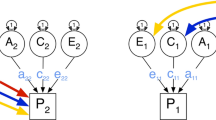Abstract
Associations between initial and 10-year follow-up assessment of the Type A behavior pattern (TABP) were examined in a sample of adult male twins using a broad range of instruments. When assessment is made by the Structured Interview and limited to the dichotomous Types A and B rating, 67% of the subjects received the same rating on both occasions. Spearman rank correlations between repeated self-report measures of TABP ranged from .55 to .70. Overall the stability among the self-report measures was greater than between the self-reports and the Structured Interview. Utilizing the twin design the relationship of genetic and environmental factors to tracking of TABP was examined and compared between monozygotic and dizygotic twin pairs. The implication of these results to the TABP contruct is discussed.
Similar content being viewed by others
References
Bortner, R. W., and Rosenman, R. H. (1967). The measurement of pattern A behavior.J. Chron. Dis. 20: 525–533.
Byrne, D. G., Rosenman, R. H., Schiller, E., and Chesney, M. (1985). Consistency and variation among instruments purporting to measure the Type A behavior pattern.Psychosom. Med. 47: 242–261.
Chesney, M. A., Black, G. W., and Chadwick, J. H. (1981). Psychological correlates of the Type A behavior pattern.J. Behav. Med. 4: 217–229.
Cohen, J. (1960). A coefficient of agreement for nominal scales.Educ. Psychol. Meas. 20: 37–46.
Feinleib, M., Christian, J. C., Borhani, N. O.,et al. (1976). The NHLBI twin study of cardiovascular disease risk factors: Organization and methodology.Acta Genet. Med. Gemellol. (Roma) 25: 125–128.
Freedman, D. S., Shear, C. L., Srinivasan, S. R.,et al. (1985). Tracking of serum lipids and lipoproteins in children over an 8-year period: The Bogalusa Heart Study.Prevent. Med. 14: 203–216.
Gough, H. H., and Heilbrun, A. B. (1975).The Adjective Check List, Consulting Psychologists Press, Palo Alto, Calif.
Haynes, S. G., Levine, S., Scotch, N.,et al. (1978). The relationship of psychosocial factors to coronary heart disease in the Framingham study. I. Methods and risk factors.Am. J. Epidemiol. 107: 362–383.
Jenkins, C. D., Rosenman, R. H., andf Zyzanski, S. J. (1974). Prediction of clinical coronary heart disease by a test for the coronary-prone behavioral pattern.N. Engl. J. Med. 290: 1271–1275.
Jenkins, C. D., Zyzanski, S. J., and Rosenman, R. H. (1979).Jenkins Activity Survey Manual, Psychological Corp., New York.
Koskenvuo, M., Kaprio, J., Langinvainio, H.,et al. (1981). Coronary-prone behavior in adult same-sexed male twins: An epidemiological study. In Gedda, L., Parisi, P., and Nance, W. E. (eds.),Twin Research 3: Epidemiological and Clinical Studies, Alan R. Liss, New York.
Light, R. J. (1971). Measures of response agreement for qualitative data: Some generalizations and alternatives.Psychol. Bull. 76: 365–377.
Rosenman, R. H. (1978). The interview method of assessment of the coronary prone behavior pattern. In Dembroski, T., Weiss, S., Shields, J.,et al. (eds.),Coronary Prone Behavior, Springer, New York, pp. 55–69.
Rosenman, R. H., Friedman, M., Straus, R.,et al. (1964). A predictive study of coronary heart disease: The Western Collaborative Group Study.JAMA 189: 113–120
Rosenman, R. H., Rahe, H. R., Borhani, N. O., and Feinleib, M. (1976). Heritability of personality and behavior pattern.Acta Genet. Med. Gemellol. 25: 221–224.
Shekelle, R. B., Schoenberger, J. A., and Stamler, J. (1976). Correlates of the JAS Type A behavior score.J. Chron. Dis. 29: 381–394.
Thurstone, L. L. (1949).Thurstone Temperament Schedule, Science Research Associates, Chicago.
Author information
Authors and Affiliations
Rights and permissions
About this article
Cite this article
Carmelli, D., Rosenman, R.H. & Chesney, M.A. Stability of the Type A structured interview and related questionnaires in a 10-year follow-up of an adult cohort of twins. J Behav Med 10, 513–525 (1987). https://doi.org/10.1007/BF00846148
Accepted:
Issue Date:
DOI: https://doi.org/10.1007/BF00846148




